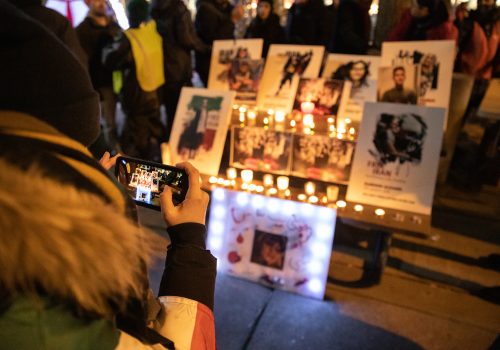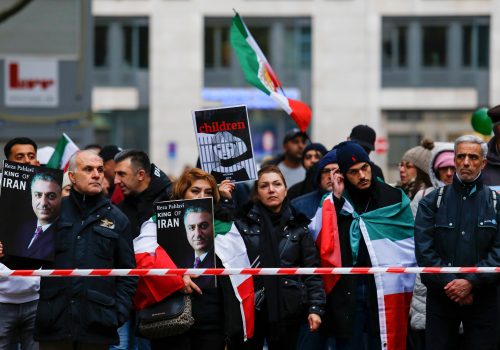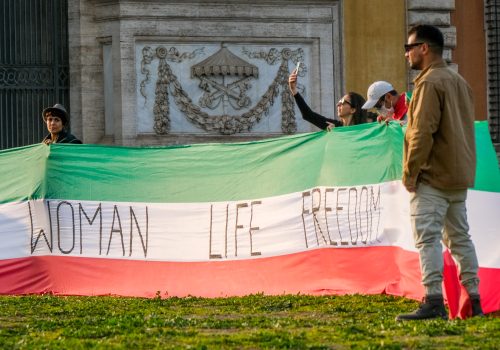After a failed coalition effort, where is the Iranian opposition headed?
EDITOR’S NOTE: This article was updated on May 12 to remove a reference to Pahlavi giving into outside pressure. His exact motives are unclear.
On February 10, a press conference hosted by the Georgetown Institute for Women, Peace, and Security led to something many Iranians had waited to see for months: a show of unity between opposition figures.
This included Reza Pahlavi, the country’s former crown prince; Masih Alinejad, a women’s rights activist against compulsory hijab; Hamed Esmaeilion, writer and advocate for the families of those killed on a Ukrainian passenger airliner downed by the Islamic Revolutionary Guard Corps (IRGC) in 2020; Shirin Ebadi, 2003 Nobel Peace laureate; Abdullah Mohtadi, once the founding leader of the Communist Party of Iran and now head of the left-wing Komala Party of Iranian Kurdistan; Nazanin Boniadi and Golshifteh Farahani, two popular actresses based in the United States and France, respectively; and Ali Karimi, one of Iran’s best-known soccer legends, now an anti-regime activist based in Germany.
Speaking at the event, the group pledged unity and said they would publish a charter of demands within a month. However, when this document, known as the Mahsa Charter, was finally published on March 13, it had already lost the support of Karimi—a firm supporter of Pahlavi—and Farahani, who made no explanation for their absence. This was the beginning of a process of losing supporters that quickly led to the group’s disintegration.
Cracks were visible from the outset, with much of the division revolving around Pahlavi’s persona. Some in the Iranian opposition have been long skeptical of his ambition. While Pahlavi has attempted to espouse broadly liberal democratic politics, many of his right-wing supporters are said to be chauvinistic, aggressive, and opposed to working with others.
Within hours of the charter’s publication, many supporters of Pahlavi went on social media to attack the coalition, christened the Alliance for Freedom and Democracy in Iran (AFDI), and its new charter. Much of their complaints ranged from vague to conspiratorial. Some complained that the phrase “the Iranian nation” had not been used even though the text spoke of “the people of Iran” and committed itself to the country’s territorial integrity. Some complained about the clenched fist logo used by ADFI, claiming it signaled a hidden leftist agenda.
On April 4, Pahlavi declared that he had asked his coalition partners to include new figures in the ADFI. Less than a week later, he claimed the group had failed to “come to a consensus” on the inclusion of these figures and added that he won’t “limit [himself] to one group.” Pahlavi seemingly, in effect, torpedoed the coalition with one tweet. Under the barrage of personal attacks launched by many Pahlavi supporters, Boniadi temporarily deactivated her Twitter account (she came back on May 1).
The group’s demise was confirmed on April 16 when Pahlavi declared a momentous trip to Israel, where he was hosted by Intelligence Minister Gila Gamliel. In Israel, Pahlavi met twice with Prime Minister Benjamin Netanyahu and once with President Isaac Herzog. He also took part in Israel’s Holocaust Memorial Day ceremonies at Yad Vashem, prayed at the Western Wall, visited the Baha’i gardens in Haifa, and also met with members of the Israeli-Iranian community.
The trip wasn’t necessarily controversial for many Iranians. Most major forces in the Iranian opposition—including center-left and far-left groups—advocate for the normalization of relations between Iran and Israel and oppose the regime’s anti-Israel and anti-Semitic policies. Alinejad openly supported the trip, and none of the ADFI figures opposed it. However, the fact that Pahlavi had gone on the trip solo showed (in addition to his previous tweets) that the sun was setting on a coalition that was only a few weeks old.
On April 21, Esmaeilion declared that he was leaving the coalition due to “pressures from outside, pressed via undemocratic methods.” Pahlavi had resisted demands for the formation of a more structured organization for ADFI, Esmaeilion said. On April 26, Alinejad, Mohtadi, Boniadi, and Ebadi effectively published the obituary of ADFI, declaring it had come to an end while pledging that they were committed to working together in future joint efforts. The new coalition, which had given hope to many, had come to an ignominious end in less than two months.
In media interviews, Esmaeilion insisted that Pahlavi’s trip to Israel had nothing to do with his decision to leave the ADFI. In fact, Esmaeilion said he had deliberately postponed leaving the group so that he could wait for Pahlavi’s trip to finish. As expected, pro-regime media in Iran salivated over the news of the coalition’s collapse and covered it widely. Mehdi Chamran, a conservative head of Tehran’s city council, gleefully declared that “their coalition [had] collapsed, which shows that non-believers in Islam will never reach any results.”
Diversity of the opposition
For as long as the Islamic Republic has existed, it has faced efforts to unseat it by opposition groups based abroad. In the 1980s, just as it massacred thousands of opposition supporters inside the country, the Islamic Republic assassinated dozens of opposition leaders around the world. The victims included leaders of all hues, including former regime loyalists, nationalists, and Marxists. In the decades to come, these opposition organizations remained small, divided, and without much significance to Iranian politics. While the Iranian diaspora has had an immense cultural and social influence on Iran, its political influence has been small. Instead, groups and activists inside Iran have driven change even at the cost of relentless repression by the regime.
In the past few years, with the total sidelining of even the meekest domestic political opposition, some hoped that the opposition abroad could break this pattern and lead to change inside the country. There were many odds in their favor. Millions of Iranians get much of their news from satellite stations based in London and Washington, which give an enviable platform to the opposition, who can benefit from a diaspora that boasts millions of young and talented Iranians around the world. Yet the opposition has repeatedly failed to build any significant political organization.
Beyond the failure of attempting to build a broad front like the ADFI, no single political camp has been able to organize its own supporters either. Most ‘political parties’ abroad consist of, at most, a few dozen people, usually above the age of fifty. As a result, any significant change will likely come from inside Iran.
That being said, there have been positive developments in the diaspora. On April 22, hundreds of Iranian leftists gathered in Germany for a meeting that signaled support for a Charter of Minimum Demands published by twenty organizations in Iran, including trade unions and feminist bodies. The meeting had been endorsed by dozens of organizations, ranging from socialist and communist groups to LGBTQ+ bodies and more than one thousand activists. It also heard solidarity messages from people inside Iran, such as Reza Shahabi, the leader of Tehran’s Bus Workers Union, who is currently in Evin prison. Such meetings show the diversity of the Iranian opposition scene abroad and its many links to those inside the country.
At the same time, an inspiring show of the persistent relevance and strength of domestic opposition was on display at a virtual meeting held on April 22 and 23, but it was covered much less widely than the ADFI and its dramas. Inspired by the call for fundamental change from Green Movement leader Mir Hossein Mousavi, the 2009 presidential candidate and former prime minister under house arrest since 2012, the Saving Iran summit brought together leading lights of civic movements inside the country and in exile.
Former member of parliament (MP) Alireza Rajayi called for structures that could give leadership to the movement. California-based sociologist Nayere Tohidi called for “national solidarity against the tyrannical government,” which should include a wide range of people, from Pahlavi to those like Mostafa Tajzadeh, former deputy interior minister under reformist President Mohammad Khatami, who has been in prison since before the protests began. From their prison cells in Tehran, Tajzadeh sent a message to the gathering, as did Faezeh Hashemi, a popular former MP and daughter of late President Akbar Hashemi Rafsanjani. The latter is known for her outspoken critiques of Supreme Leader Ayatollah Ali Khamenei. Underscoring the event’s influence, the regime quickly arrested three people who had spoken there.
Pahlavi at a crossroads
The spirit of solidarity evident in the Women, Life, Freedom movement seems to be miles away from the acrimonious scene witnessed around the Iranian opposition abroad or on social media. Esmaelion’s departure came after relentless abuse was hurled at him by some supporters of Pahlavi. Such behavior isn’t limited to cyberspace. In a recent demonstration in London on April 30, supporters of Pahlavi, some of them masked, attacked Esmaeilion with foul slogans.
Pahlavi represents a figure with many contradictions. In his public pronouncements, he espouses a tolerant and liberal view and claims Martin Luther King and Gene Sharp as role models. Addressing a leadership summit by the Anti-Defamation League in Washington DC on April 30, Pahlavi sounded like an inspiring statesman, as he recounted the oppression meted out by the regime to Iran’s religious minorities while also paying homage to those like Shia Muslim Grand Ayatollah Hossein Ali Montazeri, who resisted the tyranny of the regime.
Although Pahlavi’s trip to Israel came with its own risks, it brought him gravitas and wall-to-wall coverage. While Iran’s foreign ministry declared the trip unworthy of comment, state-backed media covered it relentlessly, attracting comments and attacks by state broadcasters and clerics, showing his continued relevance.
However, critics say Pahlavi hasn’t done enough to distance himself from many of his chauvinistic supporters who don’t practice the liberal message he preaches. Some supporters predictably claim this to be a case of some “bad apples.” But the evidence doesn’t support this view.
This isn’t just about masked protesters and online trolls. Some of Pahlavi’s vocal supporters have repeatedly made divisive moves. His wife, Yasmine Pahlavi, once shocked many by sharing a message on her Instagram stories that wished “death” to “mullahs and leftists.” Some prominent supporters openly praise Parviz Sabeti, a notorious official of the Shah’s secret police, SAVAK, which was known for the gruesome torturing of opponents. Pahlavi speaks of a need for national reconciliation and even welcomes former members of the IRGC. Yet, some of his prominent supporters preach a far-right nationalism that is aggressively exclusionary to those they call the “1979ers,” which seems to include all of Iran’s leftists and republicans.
The collapse of the ADFI also showed Pahlavi’s difficulties in working with others inside an organized structure. This is more jarring when recalling his previously failed projects. In 2013, he launched the National Council of Iran with much fanfare. However, the organization withered on the vine and he resigned from its presidency in 2017. Pahlavi is, thus, at a crossroads. Does he want to be an inclusive national figure that brings together a broad coalition of pro-democracy forces against the Islamic Republic? If so, he needs to decisively break with the brewing far-right faction around him.
On the other hand, the recent troubles of the opposition and the collapse of the ADFI could also be a moment of crisis that leads to positive change. If—in political competition with Pahlavi and one another—opposition figures attempt to organize their supporters and build effective structures, Iranians will get some nascent practice at democratic politics, which they have been deprived of for years. In the absence of such organized efforts, it is unlikely that the Iranian opposition abroad can break out of its decades-long pattern of political irrelevance.
Arash Azizi is a writer and scholar based at New York University. He is the author of “The Shadow Commander: Soleimani, the US and Iran’s Global Ambitions.” Follow him on Twitter: @arash_tehran.
Further reading
Thu, Jan 5, 2023
An Iran opposition coalition was long overdue. It’s an important step forward on the rocky road to change.
IranSource By
Such a coalition is an important step forward to grant the millions-strong Iranian diaspora a unified and, thus, more effective voice to push the international community.
Tue, Jan 24, 2023
Can Reza Pahlavi help unite the Iranian opposition? A hashtag is suggesting so.
IranSource By
An Iranian journalist started the hashtag #You_Represent_Me, which was quickly picked up by thousands of other Iranians, inside and outside the country, who used it to declare their support for Reza Pahlavi.
Thu, Feb 23, 2023
Iran’s ‘women, life, freedom’ revolution has a manifesto. Here are the next steps.
IranSource By
Signed by twenty organizations and released on February 13, the manifesto gathered the support of many civil society organizations in Iran.
Image: Protesters hold pictures of Reza Pahlavi and Iranian flags during the demonstration. Protesters staged a rally in Parliament Square against the current Iranian regime and in support of Reza Pahlavi, the Crown Prince of Iran, as he visited the House of Commons for a discussion on the future of Iran. (Photo by Vuk Valcic / SOPA Images/Sipa USA)


